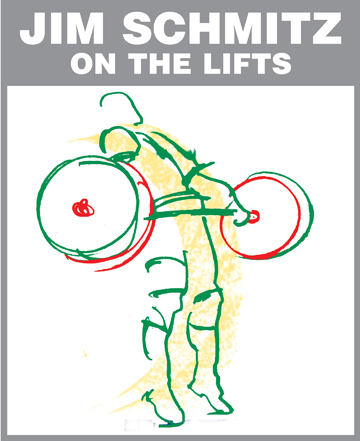
U.S. Olympic Weightlifting Team Coach 1980, 1988 & 1992 Author of Olympic-style Weightlifting for Beginner & Intermediate Weightlifters Manual and DVD
“Weightlifting is about lifting the barbell up, not lowering it,” said 1980 U.S. National champion and Olympian, Jim “Butch” Curry. That statement is quite true; however, all weightlifters really do need to learn and know how to lower a barbell safely so as not to hurt themselves, or anyone else, or damage the equipment. What I am really referring to here is lowering the barbell back to your shoulders when doing reps in the overhead lifts—military press, push press, push jerk, jerk—and behind-the-head lifts, such as overhead squats. Also, the same lowering principles apply when doing the lifts from the thighs or hang position.
If you have jerk blocks, you may not think this article applies to you. For those who may not know what jerk blocks are, they are two very large, wooden, solid, and strong boxes approximately 1-1/2’ to 2’ wide and about 3’ long where the barbell plates rest. The height is adjustable so that you need to do about a 1/4 to 5/8 squat to lift the barbell up to your standing, get-set-for-overhead-lifting position. When you complete your jerk, or whatever overhead lift you are doing, you don’t have to lower the bar back to your shoulders, you can just drop it on the blocks, and then get set and do another rep. Jerk blocks are nice if you can afford them and have space for them.
Since most people don’t have jerk blocks, they need to learn how to lower the barbell back to the deltoids and clavicles without wear and tear. Most of us began our weightlifting with home exercise barbell sets usually in the garage. Also, we began very light and the first overhead lift we did was the military press. Naturally, lowering the weights then wasn’t an issue as they were pretty light. When we got stronger, however, we realized that heavier weights could create a fair amount of pain and discomfort to the clavicles and deltoids, especially if you were on the lean side. You could create the same pain and discomfort lowering the barbell behind your head for behind-the-head lifts, and you could injure or strain your upper and/or lower back as well. So, you either figured out how to lower the barbell under control and meet the bar, or maybe you took up another form of exercise.
It’s best to learn proper lowering techniques in the beginning of your weightlifting career, but if you didn’t, it is never too late. When lowering the barbell from overhead in front of your face, you lower it under control and look at the bar by tilting your head back slightly; as the bar gets to your nose you unlock your knees slightly. When the bar is at your neck and just as it touches your clavicles and deltoids, bend your legs and flex your hips to absorb the weight. Your legs act like springs or shock absorbers—meet the bar with your clavicles and deltoids and absorb the impact with your legs. Your elbows need to be up and out in front of you, with your deltoids up as well, to provide a place for the barbell to land. The legs only need to bend a couple of inches or so, depending on the weight—the lighter the weight, the less the legs bend. Then you straighten up and get set for your next rep. I tell people this technique is a lot like catching a ball: you have to give a little, you can’t be rigid.
Lowering the barbell behind your head can be a little tricky; many people have trouble with this because obviously you can’t watch the bar. You don’t want it to hit your head or your neck; you want it to land on your traps so that it doesn’t slide down your back. As you are lowering the barbell under control, you have to bring your head forward slightly to expose your traps for the place for the bar to land. When the bar touches the traps, bend your legs a couple of inches or so and flex your hips to absorb the weight, just as when lowering in front.
When lowering the barbell either in front of or behind your head, you want your posture as straight upward as possible. There has to be a slight backward bend when lowering in front and a slight forward bend when lowering in back, but you must keep this to a minimum.
Lowering the barbell to the thighs when you are doing repetition lifts from the hang position uses the same principle. After you’ve done your hang snatch or clean, lower the barbell under control by turning your wrists over as the barbell passes your shoulders. Slow the descent of the barbell by maintaining a slight resistance against it; don’t just let it free fall. When the bar touches the thighs, bend the knees a couple of inches or so and flex your hips to absorb the weight.
Practice correct and good technique when lowering weights, don’t take it for granted. Lowering the barbell while doing repetitions is a very necessary skill and technique and will save your body for lifting weights UP.












